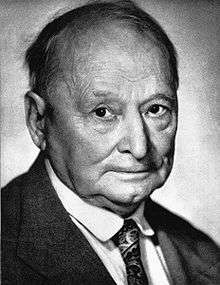Xawery Dunikowski
| Xawery Dunikowski | |
|---|---|
 | |
| Born |
24 November 1875 |
| Died |
26 January 1964 (aged 88) |
| Nationality |
|
| Awards |
|
Xawery Dunikowski (Polish pronunciation: [ksaˈvɛrɨ duɲiˈkɔfskʲi]; 24 December 1875 – 26 January 1964) was a Polish sculptor and artist, notable for surviving Auschwitz concentration camp, and best known for his Neo-Romantic sculptures and Auschwitz-inspired art.
Biography
Dunikowski was born in Kraków, a city he had an affinity for and would also use as the basis for a collection of art. When he was twelve his family moved to Warsaw, and after finishing his education in a technical school he studied sculpture under Boleslaw Syrewicz and Leon Wasilkowski. At twenty one, Dunikowski moved back to Kraków to study sculpture at the School of Fine Arts under Konstanty Laszczka, admirer of Auguste Rodin, and under Alfred Daun. He studied painting with Jan Stanisławski and after being enrolled for three years, he graduated with honors.[1]
In 1902 Dunikowski began teaching sculpture at the Academy of Fine Arts in Warsaw, a professorship he would hold until 1909 when he was appointed to Chair for Sculpture at the Jan Matejko Academy of Fine Arts in Kraków.
On January 18, 1905 he shot and killed a fellow artist and popular Warsaw society figure Wacław Pawliszczak during a quarrel in a restaurant in Warsaw, then was arrested and released on 2,000 rubles bail while charged with manslaughter (crime of passion), however, he was never really tried by the Tsarist justice system, perhaps busy with the Revolution of 1905 and other problems, therefore he, being an Austrian subject, went eventually to Kraków and never did any time nor paid any retribution to the deceased family for his crime.
Heading to Paris before the beginning of World War I, Dunikowski remained in France from 1914-1920 (he served 5 years in the French Foreign Legion) until he returned to Kraków in 1921 to take the position as head of faculty of sculpture at the Academy of Fine Arts. While working at the Academy he educated many Polish sculptors including: Jerzy Bandura, Zygmunt Gawlik, Józef Gosławski, Maria Jarema, Ludwik Konarzewski (junior), Jacek Puget and Henryk Wiciński,[2] and Polish-American woodcarver Adam Dabrowski. Dunikowski did not leave Kraków until 1940 when he was arrested by the Gestapo.
War years
Dunikowski was arrested on 15 May 1940 and deported to the Auschwitz concentration camp on 26 June 1940. In Auschwitz he was assigned the number 774. The detainment interrupted his series of sculptures entitled Heads from the Kraków Palace, based on busts found on the ceilings of Renaissance castles. Auschwitz had demoralized the artist to a point where he said that he had died there, and refused all requests, mainly by Schutzstaffel (SS) guards that urged him to make a model of the camp. Already growing old by 1942, Dunikowski became sick and was selected to be killed until his name was crossed off a list to be gassed, by a fellow Pole . Narrowly escaping death, he once again nearly met his fate in September 1943 when he was accused of belonging to the resistance movement within Auschwitz and was sentenced to be shot . However, due to further illness he was sent back to the hospital and had his sentence reduced . By 1944, still recovering in the hospital, he began to draw other prisoners. Each drawing had to be smuggled out and the ones that made it were sent back to Kraków. Dunikowski had still not completely recovered by 27 January 1945, when the Soviet Red Army liberated Auschwitz, but by 1946 returned to his position in Kraków. He also resumed working on the Heads from the Kraków Palace after the war.
Postwar period
By the time he had returned to his normal life and recovered from his illness, Dunikowski was seventy years old and had started to create larger art to coincide with many of his Auschwitz themed drawings and sculptures. His postwar interests started to drift toward architecture and tying it further into sculpture, and public monuments, most notably the Monument to the Liberation of the Region of Warmia and Mazury and the Revolutionary Effort, located in Olsztyn and at Góra Świętej Anny. Dunikowski also lived to see his works on display in his hometown of Kraków, exhibitions in Warsaw, and further exhibitions that reached all the way to Moscow and Venice by the early to mid-1950s. In 1955, Dunikowski was the subject of a documentary themed around his workshop titled Idę do słońca (I am Going to the Sun), but took little interest in the film itself or the director, Andrzej Wajda. Featured in the documentary was another famous sculpture series by Dunikowski, Kobiety brzemienne (Pregnant Women).
In the same year Dunikowski became a professor of the Academy of Fine Arts in Warsaw, leaving Kraków permanently, and also held a professorship at the State Higher School of Visual Arts in Wrocław.
In 1964, at the age of eighty-eight, Xawery Dunikowski died, leaving behind a legacy of art including some of his more famous sculptures, Macierzyństwo (Motherhood, 1900), Skupienie (Concentration), Fatum (Fate, 1904), Dante, sculpture series including the Women of Nieborow and the Jesuits' Circle, along with many illustrations, portraits, and other works. Considered to be the best 20th century Polish sculptor, Dunikowski is buried in the Alley of the Meritorious in Powązki Cemetery, Warsaw; his tomb sculpture was created by a former pupil, Barbara Zbrożyna.
Museum
The former palace in Królikarnia houses a museum dedicated to Dunikowski. In the park many of his famous works can be seen. Among which The Soul Escaping the Body (in sandstone, 1918).
References
- ↑ Figuration/abstraction: stratégies for public sculpture in Europe, 1945-1968 by Charlotte Benton
- ↑ Melbechowska Luty, Aleksandra (2005). Posągi i ludzie (in Polish). Warsaw: Neriton. p. 202. ISBN 83-89729-40-7.
![]() Media related to Xawery Dunikowski at Wikimedia Commons
Media related to Xawery Dunikowski at Wikimedia Commons
External links
- Xawery Dunikowski at Culture.pl
